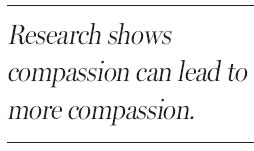How kindness can go viral
Updated: 2012-12-09 08:09
By Peter Catapano(The New York Times)
|
|||||||
Is kindness contagious? And if so, can it be spread virally?
One of the most circulated items on the Web last month was a snapshot taken by a tourist of a New York City police officer giving a pair of boots to an apparently homeless, barefoot man in Times Square. The officer, Lawrence DePrimo, found the man sitting on the ground without shoes. It was a cold night. Officer DePrimo asked the man his size, then went to a nearby store. He returned with a pair of boots, knelt beside the man and gave them to him. The man put them on and walked away.

The police department posted the photo on its Facebook page. Since that day, The Times reported, the photo has been viewed millions of times, and Officer DePrimo has been hailed as a compassionate hero in newspapers, on television and anywhere there is an Internet connection. Spirits were lifted.
But was the world now a better place?
While there is no way of knowing whether everyone who viewed Officer DePrimo's gracious act was a little nicer that day, some recent experiments suggest that. Results published in the Journal of Experimental Social Psychology showed that subjects who witnessed an act of compassion - such as one person comforting another in distress - were more likely to be more compassionate toward others immediately after.
"It seems, then," one of the researchers wrote in The Times, "that the Dalai Lama is right: the experience of compassion toward a single individual does shape our actions toward others."
Perhaps we need an example every now and then, or to recognize ourselves in the needy, to spur us on.
In another recent study, researchers found that subjects considering donating money to an anti-hunger organization gave twice as much money when shown a picture of a single victim, a 7-year-old girl, than when they were told that the charity was working to relieve the hunger of millions.
Of course, it's been argued for years that compassion is an evolutionary trait - some animals clearly exhibit it. "Human compassion, like all highly evolved social responses, is not always helpful," Benedict Carey wrote in The Times. "But to be helpful on the ground amid real suffering, it may be necessary, paradoxically, to blunt empathetic instincts."

He cited accounts that argued that the rescue workers at Hiroshima after the nuclear attack were only able to do their jobs by turning off their compassion. "Real action, when it's called for, often requires a cool heart, if not a cold one."
Evidence for this view may have arrived in early December when the man who received the boots, Jeffrey Hillman, was observed on the streets again, shoeless. "Those shoes are hidden. They are worth a lot of money," he told The Times. "I could lose my life."
Some reject the scientific explanations of human compassion. "People can perform extraordinary acts of altruism, including kindness toward other species - or they can utterly fail to be altruistic, even toward their own children," wrote Richard Polt in The Times. "Knowing how my selfish and altruistic feelings evolved doesn't help me decide at all."
Upon reading of Officer DePrimo's kind act, one Times reader wrote: "It's the multiplier effect of the reaction to this story that is stirring to me. It clearly shows that deep down we all want to do good, and to respect others."
He didn't provide an explanation. Maybe it doesn't matter why.
For comments, write to nytweekly@nytimes.com.
The New York Times
(China Daily 12/09/2012 page9)